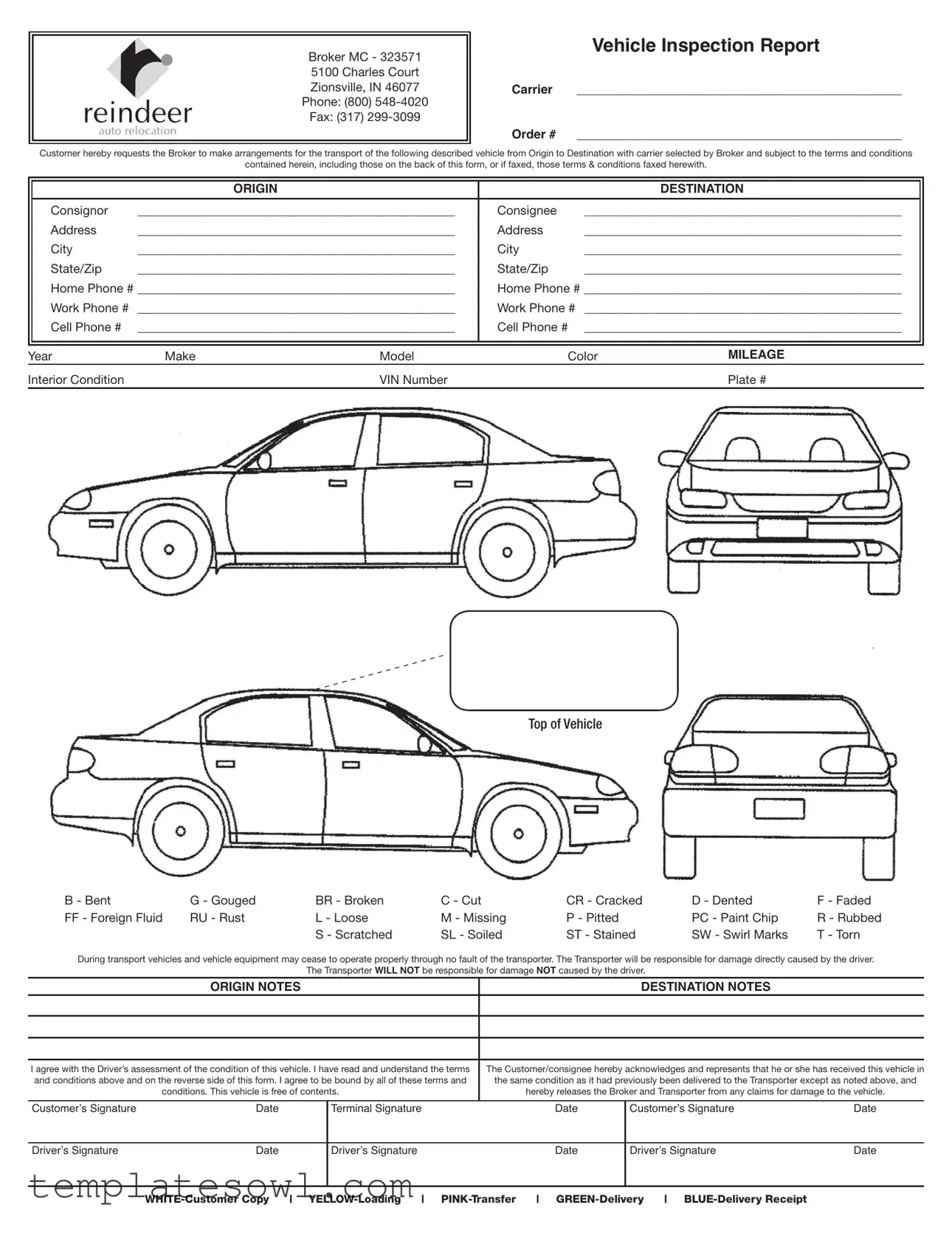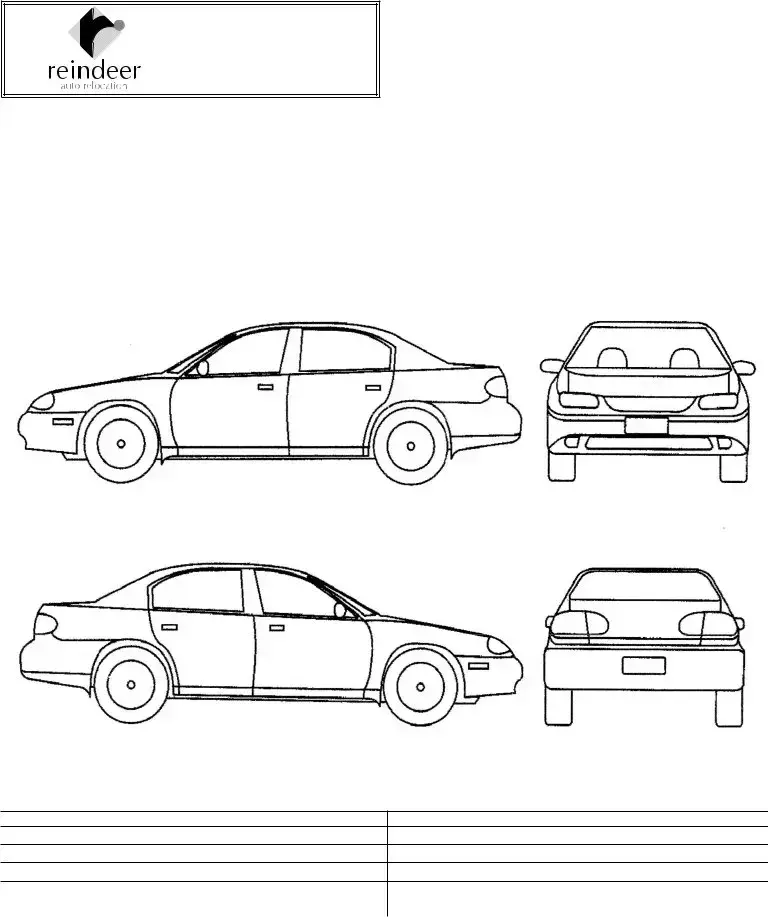Broker MC - 323571
5100 Charles Court
Zionsville, IN 46077
Phone: (800) 548-4020
Fax: (317) 299-3099
Vehicle Inspection Report
Carrier _______________________________________________
Order # _______________________________________________
Customer hereby requests the Broker to make arrangements for the transport of the following described vehicle from Origin to Destination with carrier selected by Broker and subject to the terms and conditions
contained herein, including those on the back of this form, or if faxed, those terms & conditions faxed herewith.
|
|
|
|
|
|
|
|
|
|
|
ORIGIN |
|
|
DESTINATION |
|
|
Consignor |
___________________________________________________ |
Consignee |
___________________________________________________ |
|
|
Address |
___________________________________________________ |
Address |
___________________________________________________ |
|
|
City |
___________________________________________________ |
City |
___________________________________________________ |
|
|
State/Zip |
___________________________________________________ |
State/Zip |
___________________________________________________ |
|
|
Home Phone # ___________________________________________________ |
Home Phone # ___________________________________________________ |
|
|
Work Phone # |
___________________________________________________ |
Work Phone # |
___________________________________________________ |
|
|
Cell Phone # |
___________________________________________________ |
Cell Phone # |
___________________________________________________ |
|
|
|
|
|
|
|
|
|
|
|
|
|
|
|
|
Year |
Make |
Model |
Color |
MILEAGE |
Interior Condition |
|
VIN Number |
|
|
Plate # |
Top of Vehicle
B - Bent |
G - Gouged |
BR - Broken |
C - Cut |
CR - Cracked |
D - Dented |
F - Faded |
FF - Foreign Fluid |
RU - Rust |
L - Loose |
M - Missing |
P - Pitted |
PC - Paint Chip |
R - Rubbed |
|
|
S - Scratched |
SL - Soiled |
ST - Stained |
SW - Swirl Marks |
T - Torn |
During transport vehicles and vehicle equipment may cease to operate properly through no fault of the transporter. The Transporter will be responsible for damage directly caused by the driver.
The Transporter WILL NOT be responsible for damage NOT caused by the driver.
ORIGIN NOTES |
DESTINATION NOTES |
I agree with the Driver’s assessment of the condition of this vehicle. I have read and understand the terms |
The Customer/consignee hereby acknowledges and represents that he or she has received this vehicle in |
and conditions above and on the reverse side of this form. I agree to be bound by all of these terms and |
the same condition as it had previously been delivered to the Transporter except as noted above, and |
|
conditions. This vehicle is free of contents. |
hereby releases the Broker and Transporter from any claims for damage to the vehicle. |
|
|
|
|
|
|
Customer’s Signature |
Date |
Terminal Signature |
Date |
Customer’s Signature |
Date |
|
|
|
|
|
|
Driver’s Signature |
Date |
Driver’s Signature |
Date |
Driver’s Signature |
Date |
|
|
|
|
|
|
WHITE-Customer Copy | YELLOW-Loading | PINK-Transfer | GREEN-Delivery | BLUE-Delivery Receipt
Reindeer Auto Relocation (Reindeer) General Terms & Conditions
1.Customer represents that he or she is the owner or the agent for the owner of the vehicle to be transported and by his or her signature on the other side hereof, hereby authorizes Reindeer to act as the “Broker” (as that term is defined under the Interstate Commerce Act) for arranging for the transportation of the vehicle from origin to destination as the shipper under a contract with the transporter. You will be known as the consignor and/or consignee. Customer authorizes Reindeer to enter into any contract or bill of lading with a Transporter for the purpose of providing the services requested by the customer, subject to the terms and conditions herein.
2.Customer understands and agrees that the broker is acting on behalf of the customer and that any transporter providing service requested of the broker shall be solely liable for any and all damages to the vehicle subject to the terms herein. Customer therefore agrees that upon Reindeer obtaining the transporter to provide such services, customer releases Reindeer from any further obligation herein and shall hold it harmless and blameless from any and all claims from damages.
3.Owner/customer is obligated to ensure that the vehicle being transported has been serviced properly and completely in anticipation of the elements involved in the transportation, that it is roadworthy, that it is filled with antifreeze and other necessary fluids, and that it is equipped with properly inflated tires. Customer shall be liable for any special charges incurred by transporter for loading, unloading, or storing the vehicle until delivery caused by any failure of owner/customer to comply with its obligations herein or for otherwise not having the vehicle prepared for transport.
4.Signing the transporter’s bill of lading/inspection report and/or the other side of this receipt at destination without noting any damage shall be evidence of satisfactory delivery of the vehicle free of any damage. Inspect your vehicle front and back, top to bottom, before signing your name when receiving your vehicle. Any undocumented but well substantiated damage must be reported to our office within 24 hours (1 business day) from the day of delivery.
5.Reindeer, as a broker, is not liable for damages caused by or occurring during the possession of the vehicle by the transporter. Broker shall arrange for the transporter to be liable for any damages occurring to the vehicle while in its possession subject to the specific exceptions noted below. *If damages occur during transport for which the transporter is liable, Reindeer will assist you in processing your claim against the transporter provided that you advise Reindeer within 24 hours of delivery of your vehicle at destination. Notwithstanding the foregoing at Reindeer’s sole discretion, Reindeer may settle any claim with the customer subject to the customer transferring all rights and title to any claims, which it might have, to Reindeer and granting Reindeer the sole right of subrogation against the transporter and/or other party causing said damages.
6.As a condition of recovery, any claim must be made to the transported with a copy to Reindeer Auto Relocation within nine (9) months after either the day you accept the delivery or if the vehicle is not delivered for any reason, then from the delivery date which had been scheduled. No Lawsuit may be brought after two years and one day from the date when notice is given in writing to the customer that the claim or any part of it has been disallowed.
*TRANSPORTER WILL NOT BE LIABLE FOR ANY OF THE FOLLOWING:
A. External damage to your vehicle caused by leaking fluids, either from your vehicle or any other vehicle on the transporter including but not limited to the cooling system, transmission fluid, battery acid or oil or for any industrial fall out.
B. Antennas that do not retract to less than three (3) inches above the hood or fender of the vehicle being transported or any accessories attached to the outside of the vehicle, such as but not limited to spoilers, luggage racks, etc.
C. Loss, theft, or damage to any items left in the vehicle. Since the interior of the vehicle is not inspected by the carrier, the carrier is not responsible for reported interior damage.
D. Any mechanical damage including but not limited to GPS systems, tape players, CD players, DVD players, radio or other sound or video reproducing, transmitting, or receiving equipment.
E. Mechanical functions involving and including but not limited to the engine, electrical system, exhaust assembly, alignment, suspension, brakes, transmission, frame, tires or tuning of vehicle being transported.
F. Damage which is undetectable due to vehicle’s dirty condition at the time of pickup.
G. Damage caused by road pebbles or other road objects such as but not limited to glass damage or paint chips.
H. Prior normal wear and road use such as but not limited to small scratches, paint chips, scuffs, abrasions, and parking or curb barrier damage. This also includes the under body of the vehicle.


